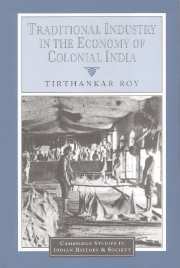7 - Carpets
Published online by Cambridge University Press: 05 July 2009
Summary
The art of pile carpets is an old one in Central and West Asia. From the early sixteenth century, with European trade in the Indian ocean and the Levant, and accelerating with subsequent European penetration into South and West Asia, carpets became an important item of trade, and evolved into a popular consumer good in Europe. The transition is significant for many reasons. In interior decoration, the nineteenth century in Europe was positively ‘the age of the tapissier’. For few other decorated objects individualized living rooms as effectively as carpets did. Carpets were the orientalist symbol par excellence. And the process had profound implications for the makers and sellers of carpets in the regions from where they continued to be exported to Europe, and, gradually, to America.
It is this last effect of a drift in consumption that this chapter addresses, with India as an example. Not as large or as differentiated as the Persian and Turkish carpets, the Indian tradition is one of the most visible examples of the integration of artisans into a world market. For India was better accessible to the West than interior Asia. The weavers' experience, in trying to cope with the new consumption, involved an almost cultural encounter that had much in common with what was going on in other decorative crafts. Before the advent of exports, carpets were made mainly in a context of patronage, for specific uses and/or users.
- Type
- Chapter
- Information
- Traditional Industry in the Economy of Colonial India , pp. 197 - 230Publisher: Cambridge University PressPrint publication year: 1999
- 1
- Cited by

